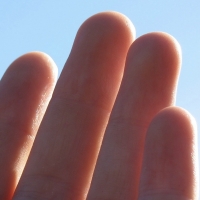Finger Vein Biometric Authentication Comes to Banking

Advances in biometric authentication technology, including voice, facial, iris (eye), and fingerprint recognition, have all been hailed as the security solutions that may finally let us give up trying to keep track of our passwords. Now Barclays, a global banking company based in London, has announced that next year the bank will begin offering its corporate banking customers a new biometric security technology that uses finger vein authentication, eliminating the need for PINs and passcodes.
Developed by Hitachi Europe Ltd, the finger vein authentication technology uses a compact device to transmit through the finger near-infrared light, which is partially absorbed by hemoglobin in the veins, to capture and read a person’s unique finger vein pattern profile. The pattern is then matched with an individual’s pre-registered profile to authenticate his identity.
Unlike fingerprinting where the biological information scanned is on the outside of the body, according to information from Hitachi, finger vein verification is based on scans of information inside the body, which makes falsification much more difficult. Since the vein must be part of a living human finger, it also eliminates the gruesome movie scenario where villains chop off someone’s finger to continue to use their prints to gain access.
The technology will initally be available to Barclay’s corporate banking clients in 2015, with the possibility of extending the service to its consumer customers in the future. Previously, Barclays introduced voice recognition biometrics to some of its customers, allowing them to identify themselves on phone calls without the need for passwords or security questions.
Currently, the finger vein technology is viewed as relatively expensive for the consumer market, reports the BBC News. "For corporate clients who do a lot of large transactions, this makes a lot of sense," said Ashok Vaswani, the CEO of Barclays Personal and Corporate Banking. Vaswani cautions that regular customers may not be willing to pay extra for this level of biometric authentication.
What do you think? How much is security and convenience worth to you?

